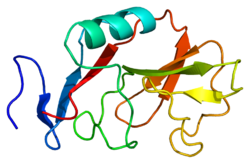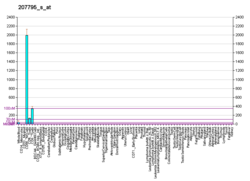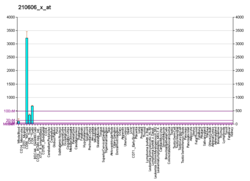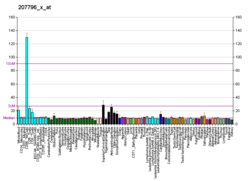KLRD1
گیرندهٔ شبه لکتینی سلول کُشنده، خانوادهٔ D عضو ۱ (انگلیسی: Killer cell lectin-like receptor subfamily D, member 1) که با نام CD94 هم شناخته میشود، یک پروتئین است که در انسان توسط ژن «KLRD1» کُدگذاری میشود.[۴]
پروتئین حاصله، نوعی لکتین، مجموعه تمایزی و گیرنده است که در پیامدهی سلولی نقش دارد و بر سطح سلولهای کشنده طبیعی در دستگاه ایمنی ذاتی بیان میشود. سلولهای کشنده طبیعی، لنفوسیتهایی هستند که در تجزیه و کشتار برخی انواع سلولهای توموری یا آلودهشده به ویروس نقش دارند و نیازی به فعالشدگی قبلی هم ندارند. این سلولها در تنظیم ایمنی سلولی و ایمنی هومورال هم دخالت دارند.
این پروتئین با مولکول KLRC2 تعامل پروتئین-پروتئین دارد.[۵][۶]
منابع[ویرایش]
- ↑ ۱٫۰ ۱٫۱ ۱٫۲ GRCm38: Ensembl release 89: ENSMUSG00000030165 - Ensembl, May 2017
- ↑ "Human PubMed Reference:". National Center for Biotechnology Information, U.S. National Library of Medicine.
- ↑ "Mouse PubMed Reference:". National Center for Biotechnology Information, U.S. National Library of Medicine.
- ↑ "Entrez Gene: KLRD1 killer cell lectin-like receptor subfamily D, member 1".
- ↑ Lazetic S, Chang C, Houchins JP, Lanier LL, Phillips JH (Dec 1996). "Human natural killer cell receptors involved in MHC class I recognition are disulfide-linked heterodimers of CD94 and NKG2 subunits". Journal of Immunology. 157 (11): 4741–5. PMID 8943374.
- ↑ Ding Y, Sumitran S, Holgersson J (May 1999). "Direct binding of purified HLA class I antigens by soluble NKG2/CD94 C-type lectins from natural killer cells". Scandinavian Journal of Immunology. 49 (5): 459–65. doi:10.1046/j.1365-3083.1999.00566.x. PMID 10320637.
- مشارکتکنندگان ویکیپدیا. «KLRD1». در دانشنامهٔ ویکیپدیای انگلیسی، بازبینیشده در ۲۹ دسامبر ۲۰۱۹.
برای مطالعهٔ بیشتر[ویرایش]
- Chang C, Rodríguez A, Carretero M, López-Botet M, Phillips JH, Lanier LL (Sep 1995). "Molecular characterization of human CD94: a type II membrane glycoprotein related to the C-type lectin superfamily". European Journal of Immunology. 25 (9): 2433–7. doi:10.1002/eji.1830250904. PMID 7589107.
- Moretta A, Vitale M, Sivori S, Bottino C, Morelli L, Augugliaro R, Barbaresi M, Pende D, Ciccone E, Lopez-Botet M, Moretta L (Aug 1994). "Human natural killer cell receptors for HLA-class I molecules. Evidence that the Kp43 (CD94) molecule functions as receptor for HLA-B alleles". The Journal of Experimental Medicine. 180 (2): 545–55. doi:10.1084/jem.180.2.545. PMC 2191622. PMID 8046333.
- Phillips JH, Chang C, Mattson J, Gumperz JE, Parham P, Lanier LL (Aug 1996). "CD94 and a novel associated protein (94AP) form a NK cell receptor involved in the recognition of HLA-A, HLA-B, and HLA-C allotypes". Immunity. 5 (2): 163–72. doi:10.1016/S1074-7613(00)80492-6. PMID 8769479.
- Lazetic S, Chang C, Houchins JP, Lanier LL, Phillips JH (Dec 1996). "Human natural killer cell receptors involved in MHC class I recognition are disulfide-linked heterodimers of CD94 and NKG2 subunits". Journal of Immunology. 157 (11): 4741–5. PMID 8943374.
- Brooks AG, Posch PE, Scorzelli CJ, Borrego F, Coligan JE (Feb 1997). "NKG2A complexed with CD94 defines a novel inhibitory natural killer cell receptor". The Journal of Experimental Medicine. 185 (4): 795–800. doi:10.1084/jem.185.4.795. PMC 2196137. PMID 9034158.
- Mandelboim O, Pazmany L, Davis DM, Valés-Gómez M, Reyburn HT, Rybalov B, Strominger JL (Dec 1997). "Multiple receptors for HLA-G on human natural killer cells". Proceedings of the National Academy of Sciences of the United States of America. 94 (26): 14666–70. doi:10.1073/pnas.94.26.14666. PMC 25087. PMID 9405670.
- Rodríguez A, Carretero M, Glienke J, Bellón T, Ramírez A, Lehrach H, Francis F, López-Botet M (Mar 1998). "Structure of the human CD94 C-type lectin gene". Immunogenetics. 47 (4): 305–9. doi:10.1007/s002510050362. PMID 9472066.
- Le Dréan E, Vély F, Olcese L, Cambiaggi A, Guia S, Krystal G, Gervois N, Moretta A, Jotereau F, Vivier E (Jan 1998). "Inhibition of antigen-induced T cell response and antibody-induced NK cell cytotoxicity by NKG2A: association of NKG2A with SHP-1 and SHP-2 protein-tyrosine phosphatases". European Journal of Immunology. 28 (1): 264–76. doi:10.1002/(SICI)1521-4141(199801)28:01<264::AID-IMMU264>3.0.CO;2-O. PMID 9485206.
- Braud VM, Allan DS, O'Callaghan CA, Söderström K, D'Andrea A, Ogg GS, Lazetic S, Young NT, Bell JI, Phillips JH, Lanier LL, McMichael AJ (Feb 1998). "HLA-E binds to natural killer cell receptors CD94/NKG2A, B and C". Nature. 391 (6669): 795–9. doi:10.1038/35869. PMID 9486650.
- Plougastel B, Trowsdale J (Apr 1998). "Sequence analysis of a 62-kb region overlapping the human KLRC cluster of genes". Genomics. 49 (2): 193–9. doi:10.1006/geno.1997.5197. PMID 9598306.
- Furukawa H, Yabe T, Watanabe K, Miyamoto R, Akaza T, Tadokoro K, Tohma S, Inoue T, Yamamoto K, Juji T (Jun 1998). "An alternatively spliced form of the human CD94 gene". Immunogenetics. 48 (1): 87–8. doi:10.1007/s002510050407. PMID 9601951.
- Lanier LL, Corliss B, Wu J, Phillips JH (Jun 1998). "Association of DAP12 with activating CD94/NKG2C NK cell receptors". Immunity. 8 (6): 693–701. doi:10.1016/S1074-7613(00)80574-9. PMID 9655483.
- Vance RE, Kraft JR, Altman JD, Jensen PE, Raulet DH (Nov 1998). "Mouse CD94/NKG2A is a natural killer cell receptor for the nonclassical major histocompatibility complex (MHC) class I molecule Qa-1(b)". The Journal of Experimental Medicine. 188 (10): 1841–8. doi:10.1084/jem.188.10.1841. PMC 2212405. PMID 9815261.
- Brooks AG, Borrego F, Posch PE, Patamawenu A, Scorzelli CJ, Ulbrecht M, Weiss EH, Coligan JE (Jan 1999). "Specific recognition of HLA-E, but not classical, HLA class I molecules by soluble CD94/NKG2A and NK cells". Journal of Immunology. 162 (1): 305–13. PMID 9886400.
- Boyington JC, Riaz AN, Patamawenu A, Coligan JE, Brooks AG, Sun PD (Jan 1999). "Structure of CD94 reveals a novel C-type lectin fold: implications for the NK cell-associated CD94/NKG2 receptors". Immunity. 10 (1): 75–82. doi:10.1016/S1074-7613(00)80008-4. PMID 10023772.
- Bellón T, Heredia AB, Llano M, Minguela A, Rodriguez A, López-Botet M, Aparicio P (Apr 1999). "Triggering of effector functions on a CD8+ T cell clone upon the aggregation of an activatory CD94/kp39 heterodimer". Journal of Immunology. 162 (7): 3996–4002. PMID 10201920.
- Ding Y, Sumitran S, Holgersson J (May 1999). "Direct binding of purified HLA class I antigens by soluble NKG2/CD94 C-type lectins from natural killer cells". Scandinavian Journal of Immunology. 49 (5): 459–65. doi:10.1046/j.1365-3083.1999.00566.x. PMID 10320637.
- Romero P, Ortega C, Palma A, Molina IJ, Peña J, Santamaría M (Aug 2001). "Expression of CD94 and NKG2 molecules on human CD4(+) T cells in response to CD3-mediated stimulation". Journal of Leukocyte Biology. 70 (2): 219–24. PMID 11493613.
- Shum BP, Flodin LR, Muir DG, Rajalingam R, Khakoo SI, Cleland S, Guethlein LA, Uhrberg M, Parham P (Jan 2002). "Conservation and variation in human and common chimpanzee CD94 and NKG2 genes". Journal of Immunology. 168 (1): 240–52. doi:10.4049/jimmunol.168.1.240. PMID 11751968.
- Terrazzano G, Zanzi D, Palomba C, Carbone E, Grimaldi S, Pisanti S, Fontana S, Zappacosta S, Ruggiero G (Aug 2002). "Differential involvement of CD40, CD80, and major histocompatibility complex class I molecules in cytotoxicity induction and interferon-gamma production by human natural killer effectors". Journal of Leukocyte Biology. 72 (2): 305–11. PMID 12149421.
پیوند به بیرون[ویرایش]
- CD94 Antigen در سرعنوانهای موضوعی پزشکی (MeSH) در کتابخانهٔ ملی پزشکی ایالات متحدهٔ آمریکا







